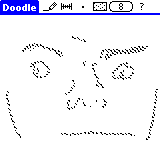
Download Doodle 0.2
Download Source 0.2
Download Doodle 0.6
Download Source 0.6
Doodle 0.6 Commands
Doo2pcx
Download Doo2pcx
Doodle History
It must have been late in 1996 or early in 1997 that Dave Sturman visited San Francisco, stopped by our house, and happened to show off his new PalmPilot. I soon had my own and started trying to teach it new tricks.
George Howlett's Scribble, now disappeared from the net, inspired Doodle both by providing the source code for a Pilot application to work from, and by providing an example of a paint program which was too minimalist to keep this doodler happy. Scribble occupied about 2000 bytes on your Palm.
This was by far the smallest drawing application available for the Palm. Others, sizes and dates from my archives, from the same era were:
- 20165 Jul 30 1996 dinkypad.prc
- 2003 Jan 28 1997 SCRIBBLE.PRC
- 4729 Mar 19 1997 ScratchPad.prc
- 3816 Apr 15 1997 doodle.prc v 0.2
- 5372 Apr 26 1997 doodle.prc v.0.6
- 25752 May 30 1997 hdsketch.prc
- 37531 Jun 4 1997 palmdraw.prc
The initial Doodle releases in March and April of 1997 rewrote Scribble from assembly code into a C program. I also increased the variety of drawing modes, pens and inks, and added some stroke smoothing to reduce the jitters. The end result was a program that occupied about 6000 bytes, and a personal aversion to programming on the Palm.
In September 1997 Kees Moerman filled Doodle's most obvious missing link by writing a Windows program, Doo2pcx, which converted DoodleDB.pdb into a collection of .pcx format images. Thanks, Kees.
In December 1998, Tom Zerucha sent a patch to add page beaming. Not having any way to test it, and still suffering from my Palm programming aversion, the patch languished in my mailbox. Thanks, Tom.
In March 1999 IDG Books asked permission to include Doodle in PalmOS Programming for Dummies.
In May 1999 I received a query from Mitch Blevins about adapting Doodle into a new program, Diddle. This soon came to pass. Diddle fixed the bug I'd never figured out, and added the mechanical drawing tools and text handling features that I hadn't considered necessary for a doodling application, and the image beaming and linking facilities that hadn't existed at the time of Doodle's release. And the program grew to 28000 bytes.
Diddle, in turn, soon grew into a program called DiddleBug, a combination note doodler and alarm setting program. The last release of DiddleBug by Mitch was 2.15 which holds 10th place on the list of most downloaded applications at PalmGear.
The current version of
DiddleBug
is hosted at
Source Forge
and maintained by Peter Putzer. If you're still using
DiddleBug 2.15, you really should upgrade because Peter
has done much excellent work on the program. But the
program has grown to 120000 bytes.
In June 1999 Chris Antos sent a fix for the menu capture bug. Thanks, Chris.
Sometime in 1999-2000, Doodle inspired Howard Katseff at ATT Research Labs to produce DoodleMail , a PalmOS e-mail client which allowed transfer of doodles between clients.
In May 2002 I received a patched version of Doodle from Rod Morehead which upgraded the build environment for the changes in the past five years and provided a fix for the color display problem. Thanks, Rod.
The current release of Doodle has benefited greatly from the many fixes and enhancements written by Mitch Blevins, Peter Putzer, and the many others who contributed to the development of Diddle and DiddleBug. This is one of the strange creative relationships that open source software allows you to enter into: you write your code, you give it away, and it comes back to you years later, all grown up. Portions of DiddleBug were incorporated wholesale, some in pieces, and all of it was studied with appreciation.
But the strangest part of rediscovering Doodle, after all these years, was that all of it was still there. When I went through the source code of DiddleBug 2.52 attempting to trim it back to the original Doodle plus those features I thought I might want to keep, I found that the original Doodle was intact, and substantially unchanged. In the end it was easier to build up from Doodle 0.6 to the new release, using the DiddleBug sources as a source of ideas.
Writing the first Doodle I discovered that a user interface can work much differently on a pen based computer. Since doodling consists of scribbling with the stylus on the screen of your Palm, it's quite natural to change pens or inks by reaching into the graffiti area and scribbling a command character. It's almost as if you reached out with your stylus and dipped it into a one ink pot of an array, but the palette of inks is organized gesturally in the graffiti stroke "space" rather than arranged physically in your workspace. The result is that the mechanics of the user interface for Doodle do not fight with the mechanics of doodling - there are no rectilinear menus that must be traversed and there are no tool bars stealing eye-share from your doodle, it's just you, your stylus, and a field of empty pixels to be filled.
Doodle 0.8 retains the simplicity of the original interface while adding a few features and still remaining quite compact at around 22000 bytes. The Add and Subtract Ink modes allow you to touch up your doodles by darkening or lightening areas. The Shift Ink operator allows you to use the basic inks in different alignments. The Pick Ink and Pick Pen dialogs allow you to build up your own palettes and toolboxes.
